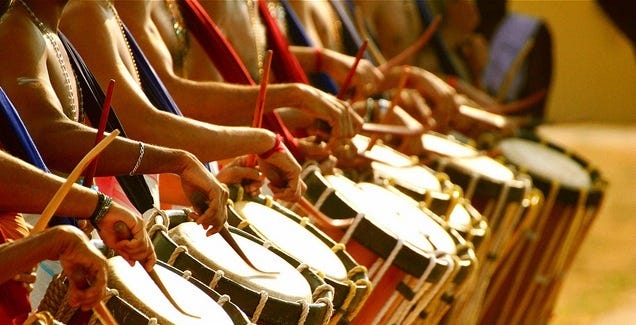Chenda Instrumental Music

Chenda Introduction The Chenda is a cylindrical percussion instrument used widely in the state of Kerala, Tulu Nadu of Karnataka and Tamil Nadu in India. In Tulu Nadu it is known as chande.
May 18, 2017 - Instrumental music of Kerala, especially percussion, has a highly advanced tala system that is. Chenda melam Photo Credit: Thulasi Kakkat.
It is a cylindrical wooden drum, and has a length of two feet and a diameter of one foot. Both ends are covered with the “Chenda_Vattam”. The animal skin is usually of a cow, in a traditional Chenda other skins are not used, to have a quality sound the skin from the abdominal part of the cow is taken. This instrument is suspended from the drummers neck so that it hangs vertically.
Though both sides can be used for playing, only one is actually beaten. Using two sticks, the drummer strikes the upper parchment. This instrument is famous for its loud and rigid sound. A Chenda has two sides, the left side called “Edamthala” and the right side “Valamthala”. The “Edamthala” is made of only one/two layer of cow skin and the “Valamthala” will have a five/seven layer skin, so as to have a bass sound. The skin are dried under shadow and fastened on wooden rings made of the trunk of a locally available palm tree or bamboo, using a gum prepared from the seed of a tree called “pananchi maram”.
The circular frame is kept in a vessel and boiled for a whole long day and then bended in the form of circle and drying it up. The body of the Chenda which is 2 ft 36 inches diameter and 1.5 inches thickness is made of the soft wood of the jackfruit tree. The thickness is again reduced by 0.25 inches, at simultaneous points separated by 4 inches.
This is done in order to produce highly resonating sound. Only the wooden rings with the skin is replaced once the quality of the sound is not up to the mark. For regular Chenda artistes an average of 15 rings are required every year.
The Chenda is mainly played in Hindu temple festivals and as an accompaniment in the religious art forms of Kerala. The chenda is used as an accompaniment for Kathakali, Koodiyattam, Kannyar Kali, Theyyam and among many forms of dances and rituals in Kerala. It is also played in a dance-drama called Yakshagana (Tenku Thittu) which is popular in Tulu Nadu of Karnataka. There is a variant of this instrument used in northern school of Yakshagana called Chande. It is traditionally considered to be an Asura Vadyam which means it cannot go in harmony.
Chenda is an unavoidable musical instrument in all form of cultural activities in Kerala. In Kerala the craft of making Chenda is now associated with some few “Perumkollan” (smith) families at Peruvembu, Nemmara, Lakkidi[disambiguation needed], Vellarkad and Valappaya villages. Many famous Chenda percussionist in Kerala make there Chendas from Vellarkad village for it is famous for the quality of the instrument. Igri udiviteljnij mir gampola koshmar iz holodiljnika. Types of Chenda Chendas are of different types, depending upon the diameter of the “Chenda_Vattam” they are called “Ettara_Veechan_Chenda”, “Ompathu_Veechan_Chenda”, “Ompathe_Kal_Veechan_Chenda”, “Ompathara_Veechan_Chenda”, “Ompathe_Mukkal_Veechan_Chenda”, “Ompathe_Mukkal_Kali_Chenda”. These Chendas are used for different purposes especially for different art forms. Depending upon the size, structure and function of the Chenda, they are classified as, “Veekku_Chenda” or “Acchan_Chenda”, “Uruttu_Chenda”, “Muri_Chenda” etc. “Uruttu_Chenda” is used to play variations in music.
It is used to lead the orchestra. It is called the “”Pramanavadhya”” (Leading instrument). The “Chenda _attam” of the “Uruttu_Chenda” is always the “Edam Thala” or the “Left Head” which is made of soft, single cow skin. The meaning of “uruttu” in Malayalam language is “rolling”.